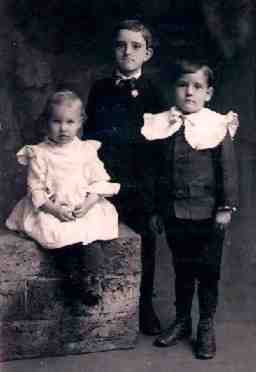
Figure 1.--This American boy pictured with his siblings wear a huge ruffled collar with a small bow. His older brother wears a more adult looking suit. |

|
Ruffled collars for boys declined in popularity after the mid-19th Century. Rather large lace collars, often with ruffles, worn with elaborate bows were often part of Fauntleroy suits that were all the eage for younger boys and even a few older boys. At the turn of the century the
Buster Brown outfit appeared which involved large plain white cloth collars. Older boys wore uncomfortable looking stiff Eton collars with their suits.
It was not until the 1870s that boys collars again began to increase in size. Many boys in the early-1870s still wore small collars. A good example is Minnie Tamn, a Minnesota boy who we believe had his portrait taken in the 1870s. , but by the mid-1870s the trend toward larger collars was increasingly pronounced. We do not see huge collars, but we do begin to see moderate-size collar. A good example is an unidentified English boy during the 1870s. Developing Victorian clothes increasingly involved closed collars which by the the 1880s became quite elaborate. The large Fauntleroy collars of the 1880s and 1890s often were lace collars, some with ruffles. The style looked much less comfortable for the boys so outfitted. Ruffled collars continued to be worn, but not as commonly and generally in a closed more formal style. Unlike lace collars which were growing in popularity during the 1860s and especially in the 1870s, ruffled collars were not generally worn with bows. Most ruffled collars, however, were worn with matching wrist ruffles. The collars could be very large. Some covered the entire shoulder area of a boy's suit. They could be worn with quite large bows, although the size of the bow was variable. Most boys wore bows with their ruffled collars before the turn of the cetury. After the turn of the century it became more common to wear ruffled collars without a bow.
We note two basic styles of ruffled collars, both small ruffs and large Fauntleroy collars. . The first was popular in the mid-19th century and was more of a ruff--small ruffles at the neck. Whilemost common at mid century, we see themlater as well. A good example is R. Demarst, a Chichsgo 6-year old. The second style of ruffled collar
was popular in the late-19th and very early-20th centuries. It was a massive collar Fauntleroy collar with the ruffles onlu used for edging.
Another feature of ruffled collars was the matching wrist ruffles. The size of the wrist ruffles usually matched the size and style of the collar ruffles.
Boys weraring large ruffled collars, might have wrist ruffles extending about half way between the wrist and elbow. While most commonly worn with Fauntleroy suits, wrist ruffles could be worn with other styles as well.
Large ruffled collars were most prominently worn as part of Litle Lord Fauntleroy suits. The were, however, not exclusively worn with Faintleroy suits.
The prmimary fashion associated with
ruffled collars in the late 19th Century was the Fauntleroy suit. Ruffled were used on collars, but the most popular collar worn with Fauntleroy suits was the lace collar.
Specialized boys' dresses appeared during the late 19th Century although most young children's dresses were generic garments for boys and girls. The ruffled collars were more extensively used for girls' dresses as the boys' dresses tended to be plainer.
Sailor suits for older boys tended to follow the
classic style, however, those for younger boys could be more faciful. Some had lace or rullles around the collar, dickey, or back flap.
Young boys who ha d passed from Fauntleroy and sailor suits were purchased rather modern looking suits. It was common for the youngers boys to wear their new suits with their Fauntleroy collars and large bows rather than the cravat worn by older boys with their suits. The ruffled collars could thus be worn with otherwise quite adult looking jacket styles, including the new double breasted style which became popular in the 1890s.
While the rufled collars were worn with many styles of jackets,
almost always they were only worn kneepants suits. Once a boy began
wearing long pants, it was no longer considered appripriate to wear
large ruffled collars.
The popularity of ruffled collars varied from country to country. And this varied over times. The collars we see in the 1870s are moderate sized. We see boys wearing ruffled collars in American, Englasnd, France, and Germany. While we have general information on these countries, we are still working on the 1870s. A good example is an unidentified English boy during the 1870s.
Navigate the Boys' Historical Clothing Web Site:
[Return to the Main ruffled collar chronology page]
[Return to the Main collar page]
[Introduction]
[Activities]
[Biographies]
[Chronology]
[Clothing styles]
[Countries]
[Bibliographies]
[Contributions]
[FAQs]
[Images]
[Links]
[Registration]
[Boys' Clothing Home]
